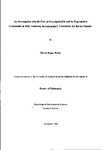An Investigation into the Fate of Benzylpenicillin and its Degradation Compounds in Milk Following Intramammary Treatments for Bovine Mastitis
| dc.contributor.author | Hulse, David Roger | |
| dc.contributor.other | School of Biological and Marine Sciences | en_US |
| dc.date.accessioned | 2013-10-23T09:58:11Z | |
| dc.date.available | 2013-10-23T09:58:11Z | |
| dc.date.issued | 1996 | |
| dc.identifier | NOT AVAILABLE | en_US |
| dc.identifier.uri | http://hdl.handle.net/10026.1/2308 | |
| dc.description.abstract |
The presence of antibiotics in bovine milk results mainly from the treatment of mastitis by intramammary infusion. The sale of this contaminated milk is illegal and the milk supply is routinely tested for adulteration by antibiotic residues. At present these tests are unspecific microbiological assays which detect only inhibitory substances and consequently the presence of any inactive degradation compounds is not tested for. Various chromatographic approaches exist in the literature which report the resolution of mixtures of antibiotic compounds from milk. However, the presence of antibiotic degradation residues in milk, which may have serious implications for the health of the consumer, has not been studied. Benzylpenicillin is the antibiotic responsible for most failures of the regulatory tests and is present in the majority of common mastitis treatments. Although often administered as the procaine salt it degrades rapidly, especially in the presence of P-lactamase enzymes produced by resistant strains of bacteria. This thesis initially describes the development of a chromatographic system for the detection and separation of benzylpenicillin and its major degradation compounds in aqueous solution. HPLC and the relatively recently developed technique of Micellar Electrokinetic Capillary Chromatography (MECC) were both successfully employed to perform this function. An important part of the research, however, was the development of an efficient milk extraction and sample clean up technique, complicated by the complexity of the milk matrix and also the instability of benzylpenicillin. HPLC was found to be unsuitable for the resolution of the degradation compounds from milk because of background interference despite extensive sample clean up by methods reported in the literature and developed during the course of this work. MECC on the other hand provided the necessary resolution for the detection of these compounds without the need for extensive sample manipulation. The final novel procedure was a combination of acetonitrile extraction coupled with solid phase clean up which took into consideration the presence of proteins, carbohydrates and lipids; the major constituents of the milk matrix. The preparation and identification of the major aqueous degradation compounds of benzylpenicillin was achieved and confirmed by NMR and FTIR studies. The action of β-lactmases (penicillinase) on penicillin to produce benzylpenicilloic acid and its subsequent epimerisation from the 5R,6R diastereoisomer to the 5S,6R epimer is also reported. Once the optimum milk extraction and purification methods had been found, they were applied to milk collected from cows treated for mastitis with two different infusions containing benzylpenicillin. From these in-vivo samples it was apparent that only one penicillin degradation compound, 5R,6R benzylpenicilloic acid, was present in milk following intramammary treatment. When the benzylpenicillin was administered as the procaine salt the benzylpenicilloic acid was detectable in the milk during the entire 72 hour withdrawal period. | en_US |
| dc.language.iso | en | en_US |
| dc.publisher | University of Plymouth | en_US |
| dc.title | An Investigation into the Fate of Benzylpenicillin and its Degradation Compounds in Milk Following Intramammary Treatments for Bovine Mastitis | en_US |
| dc.type | Thesis | |
| dc.identifier.doi | http://dx.doi.org/10.24382/3610 | |
| dc.identifier.doi | http://dx.doi.org/10.24382/3610 |
Files in this item
This item appears in the following Collection(s)
-
01 Research Theses Main Collection
Research Theses Main


